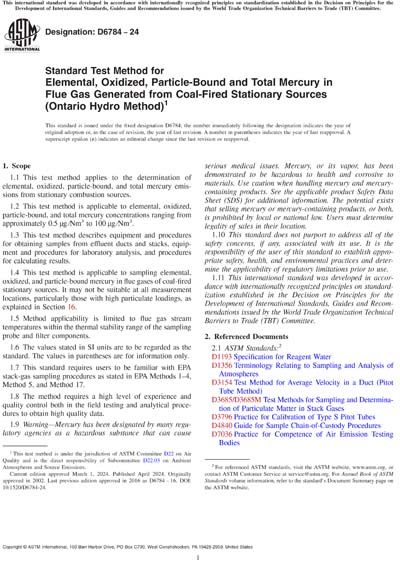Most recent
ASTM D6784-24
Standard Test Method for Elemental, Oxidized, Particle-Bound and Total Mercury in Flue Gas Generated from Coal-Fired Stationary Sources (Ontario Hydro Method)
1.1 This test method applies to the determination of elemental, oxidized, particle-bound, and total mercury emissions from stationary combustion sources.
1.2 This test method is applicable to elemental, oxidized, particle-bound, and total mercury concentrations ranging from approximately 0.5 g/Nm3 to 100 g/Nm3.
1.3 This test method describes equipment and procedures for obtaining samples from effluent ducts and stacks, equipment and procedures for laboratory analysis, and procedures for calculating results.
1.4 This test method is applicable to sampling elemental, oxidized, and particle-bound mercury in flue gases of coal-fired stationary sources. It may not be suitable at all measurement locations, particularly those with high particulate loadings, as explained in Section 16.
1.5 Method applicability is limited to flue gas stream temperatures within the thermal stability range of the sampling probe and filter components.
1.6 The values stated in SI units are to be regarded as the standard. The values in parentheses are for information only.
1.7 This standard requires users to be familiar with EPA stack-gas sampling procedures as stated in EPA Methods 1–4, Method 5, and Method 17.
1.8 The method requires a high level of experience and quality control both in the field testing and analytical procedures to obtain high quality data.
1.9 Warning—Mercury has been designated by many regulatory agencies as a hazardous substance that can cause serious medical issues. Mercury, or its vapor, has been demonstrated to be hazardous to health and corrosive to materials. Use caution when handling mercury and mercury-containing products. See the applicable product Safety Data Sheet (SDS) for additional information. The potential exists that selling mercury or mercury-containing products, or both, is prohibited by local or national law. Users must determine legality of sales in their location.
1.10 This standard does not purport to address all of the safety concerns, if any, associated with its use. It is the responsibility of the user of this standard to establish appropriate safety, health, and environmental practices and determine the applicability of regulatory limitations prior to use.
1.11 This international standard was developed in accordance with internationally recognized principles on standardization established in the Decision on Principles for the Development of International Standards, Guides and Recommendations issued by the World Trade Organization Technical Barriers to Trade (TBT) Committee.
Content Provider
ASTM International [astm]






